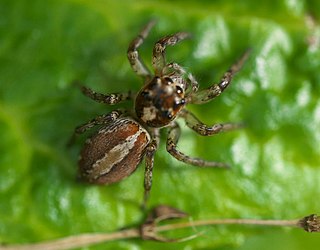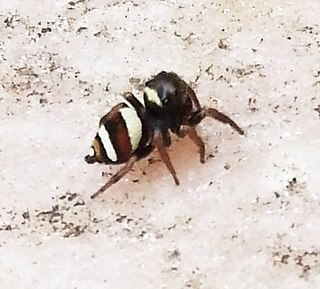
Amaurobiidae is a family of three-clawed cribellate or ecribellate spiders found in crevices and hollows or under stones where they build retreats, and are often collected in pitfall traps. Unlidded burrows are sometimes quite obvious in crusty, loamy soil. They are difficult to distinguish from related spiders in other families, especially Agelenidae, Desidae and Amphinectidae. Their intra- and interfamilial relationships are contentious. According to the World Spider Catalog, 2023, the family Amaurobiidae includes 286 species in 50 genera.

Xysticus is a genus of ground crab spiders described by C. L. Koch in 1835, belonging to the order Araneae, family Thomisidae. The genus name is derived from the Ancient Greek root xyst, meaning "scraped, scraper".

Pancorius is a genus of Asian jumping spiders that was first described by Eugène Louis Simon in 1902. They are similar to Hyllus.

Plexippoides is a genus of jumping spiders that was first described by Jerzy Prószyński in 1984. The name means "having the likeness of Plexippus"

Ptocasius is a genus of Asian jumping spiders that was first described by Eugène Louis Simon in 1885.

Synagelides is a genus of Asian jumping spiders that was first described by W. Bösenberg & Embrik Strand in 1906. This genus and Agorius are separated as a genus group, sometimes called subfamily Agoriinae, but more recently downranked to tribe Agoriini of the Salticoida clade in subfamily Salticinae.

Pimoa is a genus of spiders in the family Pimoidae. Its sister genus is Nanoa.

Agelena is a genus of agelenid spiders first described by Charles Athanase Walckenaer in 1805. Sometimes referred to as Eurasian grass spiders, they trap their prey by weaving entangling non-sticky funnel webs. They are limited to the Old World, occurring from Africa to Japan. Many species have been moved to other genera, particularly to Allagelena, Benoitia and Mistaria.

Plebs is a genus of orb-weaver spiders first described by M. M. Joseph & V. W. Framenau in 2012. Though many of its species have been moved around, a 2012 taxonomic revision suggested that these spiders comprise a monophyletic genus of closely related spiders that evolved in Australia and, through subsequent movements, spread into parts of Asia and Pacific islands.

Allagelena is a genus of Asian funnel weavers first described by Z. S. Zhang, Ming-Sheng Zhu & D. X. Song in 2006.
Psechrus is a genus of cribellate araneomorph spiders in the family Psechridae, and was first described by Tamerlan Thorell in 1878.

Tylorida is a genus of long-jawed orb-weavers that was first described by Eugène Louis Simon in 1894.
Himalcoelotes is a genus of Asian funnel weavers first described by X. P. Wang in 2002. They are mostly found in China and Bhutan.

Eriovixia is a genus of orb-weaver spiders first described by Allan Frost Archer in 1951.
Indophantes is a genus of Asian dwarf spiders that was first described by Michael I. Saaristo & A. V. Tanasevitch in 2003.

Lysiteles is a genus of Asian crab spiders first described by Eugène Simon in 1895.
Troglocoelotes is a genus of east Asian funnel weavers. It was first described by B. Li, Z. Zhao and C. T. Zhang in 2019, and it has only been found in China.
Draconarius is a genus of Asian funnel weavers first described by S. V. Ovtchinnikov in 1999.
Orientattus is a genus of Asian jumping spiders erected by John Caleb in 2020. It is placed in the tribe Plexippini, within the Salticoida clade of Salticinae. In 2018 and 2019, a species found in Sri Lanka and India was placed in the otherwise African genus Schenkelia under the name "Schenkelia aurantia", however, this species differed significantly from the type species of the genus Schenkelia. Three other species, placed in different genera, were found to resemble Schenkelia aurantia, and these were all combined to create the genus, Orientattus.












